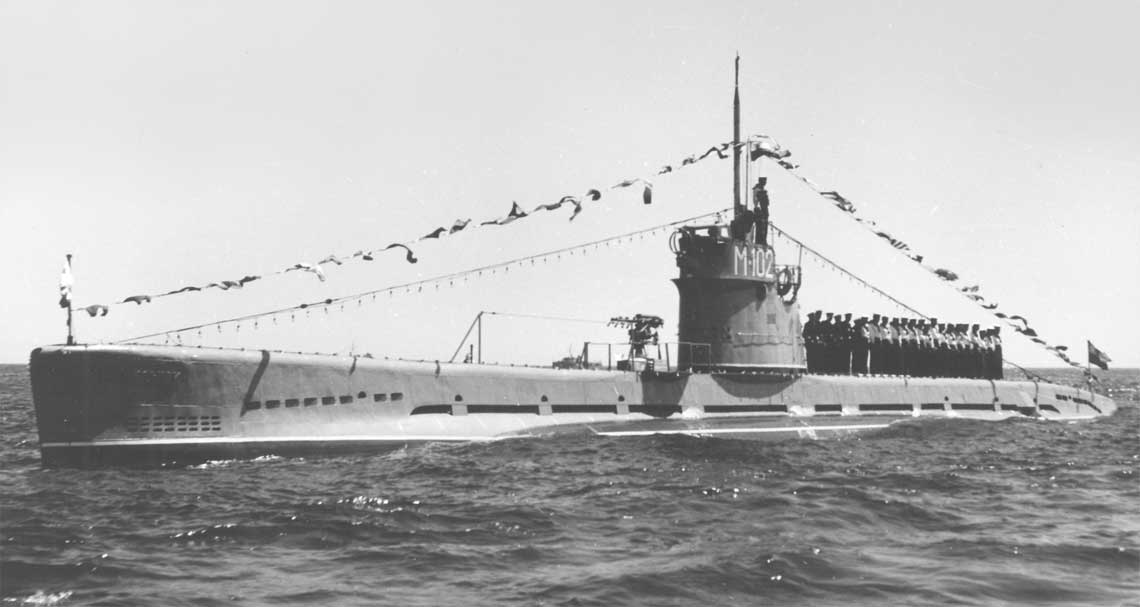
Project 96, called Small

ORP Krakowiak during the Sea Festival in 1956. Marking M-102 is visible on the kiosk, and in front of the kiosk is a 21-mm 45-K cannon. Photo collection of the MV Museum
Project 96 submarines, popularly known as "Baby", were the most numerous type of submarines in our fleet. Six ships raised the white and red flags in just 12 years (from 1954 to 1966), but their decks became an important breeding ground for our submarines. They were the first step in the transition from Western to Soviet submarine weapons.
Three pre-war submarines, namely ORP Sęp, ORP Ryś and ORP Żbik, which returned to Gdynia from internment in Sweden on October 26, 1945, were the only ones in their class to fly the white and red flags for the next 9 years. In 1952, the ORP Wilk was brought from the UK, but it was no longer suitable for further military service. After removing all possible mechanisms for spare parts for two twins, a year later the disassembled hull, judging by the meager archival documents on the subject of this unit, was flooded near the Formosa hull at the northern entrance to the port
in Gdynia.
Ambitious plans
Although the first project 96 warship was commissioned into our fleet in October 1954, plans for their acceptance, it seems, date back to May 1945. Then, during the first meeting in Moscow on the reconstruction of the Navy in the Coastal area liberated from the Germans - the list of ships that the Red Fleet was ready to transfer after the training of the relevant marine personnel included 5-6 submarines. Unfortunately, this is so far the only clue found in this case, so we know nothing about the possible type, and the Command of the Navy (DMW), created on July 7, 1945, initially refused to accept units of this type. class. His decision was influenced by the lack of an appropriate number of trained specialists who could be entrusted with service in underwater units. The very fact that there were major personnel problems with the total number of three aircraft returned by Sweden shows that this assessment was absolutely correct.
However, already in the planning documents from the end of 1946 we can detect an increase in "appetites" for a significant expansion of the fleet. The plan was prepared under the auspices of the then Commander-in-Chief of the Navy, Kadmiya. Adam Mokhuchy, dated November 30, 1946. Among the total number of 201 ships that were planned to be commissioned in 1950-1959, there were 20 submarines with a displacement of 250-350 tons, and therefore classified as a small subclass. A dozen were to be based in Gdynia and eight more in Kołobrzeg. The next MW commander, Cadmius, was more sober in his views on expansion. Wlodzimierz Steyer. In the plans of April 1947 (repeated a year later), going back to the past for the next 20 years, there were no light cruisers or destroyers, and the Wishlist began with caretakers.
The column "submarines" includes 12 small (with a displacement of up to 250 tons) and 6 medium (with a displacement of 700-800 tons) units of this class. The Polish naval commanders of the armed forces, unfortunately, did not have real opportunities to implement their plans. Many factors stood in the way. Firstly, they did not fulfill their duties for a long time, in September 1950, with the advent of the next (after the war) wave of Sovietization of our army, Cadmium was placed at the head of the MV. Victor Cherokov. Secondly, there was no "climate" for a significant expansion of the fleet. Even the Polish staff officers from Warsaw, based on their pre-war and military experience, did not foresee any significant tasks for her. Similar views, prevailing at that time in Moscow, suggested that the closed naval fleet should expand the light and coastal forces, designed to defend their own coast and escort convoys in the coastal zone. It is not surprising then that the plan for the development of the fleet brought “in the portfolio” by Cherokov assumed the creation by 1956 of only minesweepers, pursuers and torpedo boats. There were no submarine columns.